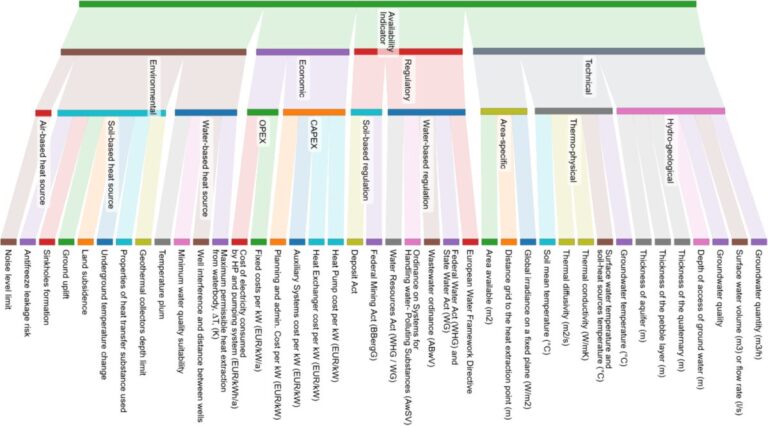The Fraunhofer Isee has designed a new method for assessing the potential of heat sources for low temperature for large -scale heat pumps. The five -step process was tested on the German city of Fellbach, so that the heat sources with LCOH were lower than € 0.1/kWh lower.
Researchers at the Fraunhofer Institute for Solar Energy Systems (Fraunhofer Isee) of Germany have proposed a new method for assessing and comparing heat sources for low temperature for integration with industrial heat pumping activities.
The proposed method is based on five steps: identifying heat sources; evaluation of their heating availability and potential; approaching the costs of the extraction and the offer of heat source; comparing the possibilities and costs; And finally provide recommendations to municipal heating calers.
“All local municipal heat sources must be assessed on their potential and availability,” the group said. “The individual assessment of each heat source, including air (ambient and exhaust), water (rivers, lakes, oceans, waste water) and soil (surface and deep geothermal) will contribute to a better informed decision -making for municipal energy planners. In this respect, this article suggests a indicator-based heat source evaluation method using open-source data. “
The first step uses open-source geographical information tools such as Open-Streetmap. This information – which includes industrial locations, waste water treatment plants, water wells and river and multi -areas – is collected within a Geo information system (GIS). However, the team emphasizes that heat sources such as deep geothermal, data centers, mines and industrial waste heats may not be identifiable without detailed research.
The second step includes the consideration of all different indicators for potential heat sources with a low temperature. A total of 40 indicators are considered in technical, regulatory, economic and environmental categories. Various calculations, based on those indicators, are used to assess the potential of the various air-based, water-based, and solar energy-based heat sources.
The next step is the cost approach, which is based on technical potential assessment. “Every identified heat source is evaluated on the basis of the expected investment and operating costs of thermal generation units. The required generation capacity is linked to the heat demand close to the location in an area of two by two km2 to allocate the possible capacity sizes of heat exchangers, building measurements, heat pumps, control and other required generation components and to allocate their costs and their costs All to be allocated, “the academics explained.
The fourth step of the proposed method compares the results in four frameworks. The first is compression in absolute terms by heat exchanger and source, as annual energy roofs for the specific analyzed area. The second is a relative comparison when only sources of the same geographical type are compared. The third framework compares the certainty of heat sources based on a quantitative assessment of the data quality. The last proposed framework compares the heat sources with the level of heat (LCOH).
Image: Fraunhofer Institute for Solar Energy Systems (ISE), Applied Energy, CC by 4.0
“The recommendation in step 5 is based on the previously introduced four steps of the methodology and concludes with a list of promising heating candidates within the chosen boundaries of the research subject,” the researchers explained. “The recommendation process summarizes the results in a repeatable way for the decisive planners.”
To demonstrate the method, the scientist took a case study from the German city of Fellbach. Located in the southwest of the country and the home base of around 45,000 inhabitants, the combined heat demand for 2022 was 472 GWH and the demand for electricity was 193 GWH. The city is mainly dependent on gas and oil boilers for heat supply.
In the first part of the method, the researchers have identified the river neck, four groundwater wells, various large industrial plants and supermarkets, and potential heat extraction areas in the vicinity of residential areas as potential heat sources. The team was able to compression based on the technical and economic estimate of each possible source.
“The Case Study-Specific LCOH for five of the analyzed sources falls under 0.1 € (0.104 $)/kWh, while the LCOH of the five soil-based heat sources exceeds more than € 0.1/kWh,” the results mentioned. “The results of the Case Study show competitive thermal supply costs for five heat sources: industrial waste heat, surface water river, thermal solar, waste water and supermarket waste heat.”
Based on LCOH compression and the other framework, the team ordered to further develop a proof of concept for extracting heat from the river water, thermal solar panels and industrial waste heat. They also recommend considering the possibility of extracting heat from a geothermal geothermal near a new residential area.
The method was presented in “Evaluation of heat sources with a low temperature for large-scale heat pumpintegration: a method using open-source data and indicators“Published in Applied energy.
This content is protected by copyright and may not be reused. If you want to work with us and reuse part of our content, please contact: editors@pv-magazine.com.
Popular content



